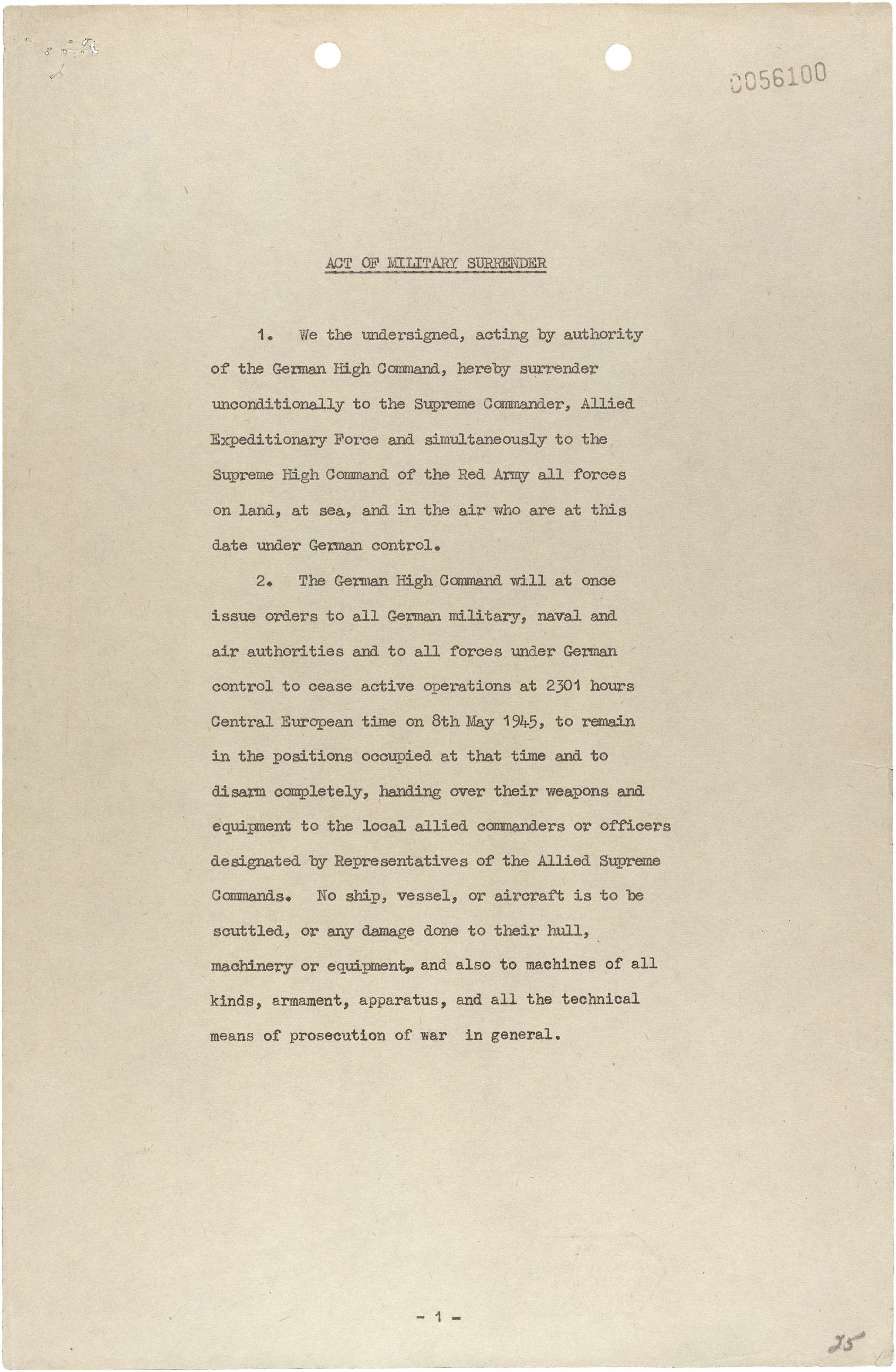Act of Military Surrender
5/8/1945
Add to Favorites:
Add all page(s) of this document to activity:

Add only page 1 to activity:
Add only page 2 to activity:
Add only page 3 to activity:
On May 7, 1945, General Alfred Jodl, Chief of Staff of the German Army, signed the unconditional surrender of the German Third Reich at General Dwight D. Eisenhower's headquarters in Reims, in northeastern France.
After the signing of the Reims accord, Soviet chief of staff Gen. Alexei Antonov expressed concern that the continued fighting in the east between Germany and the Soviet Union made the Reims surrender look like a separate peace. The Soviet command wanted the Act of Military Surrender, with certain additions and alternations, to be signed at Berlin.
The document seen here is the unconditional surrender of all German Forces to the Allied Expeditionary Force and the Supreme Allied Command of the Red Army, in which all German military operations would cease on May 8, 1945 at 2301 hours.
To the Soviets, this document signed at Berlin on May 8, 1945, represented the official, legal surrender of the Third Reich. The Berlin document had few significant changes from the one signed a day earlier at Reims.
It is signed by Generalfeldmarschall Wilhelm Keitel, Generaladmiral Hans-Georg von Friedeburg, and Generaloberst Hans-Jurgen Stumpff on behalf of the German High Command, Marshal Georgy Zhukov on behalf of the Supreme High Command of the Red Army, and Air Chief Marshal Arthur William Tedder on behalf of the Allied Expeditionary Force at Berlin, Germany.
After the signing of the Reims accord, Soviet chief of staff Gen. Alexei Antonov expressed concern that the continued fighting in the east between Germany and the Soviet Union made the Reims surrender look like a separate peace. The Soviet command wanted the Act of Military Surrender, with certain additions and alternations, to be signed at Berlin.
The document seen here is the unconditional surrender of all German Forces to the Allied Expeditionary Force and the Supreme Allied Command of the Red Army, in which all German military operations would cease on May 8, 1945 at 2301 hours.
To the Soviets, this document signed at Berlin on May 8, 1945, represented the official, legal surrender of the Third Reich. The Berlin document had few significant changes from the one signed a day earlier at Reims.
It is signed by Generalfeldmarschall Wilhelm Keitel, Generaladmiral Hans-Georg von Friedeburg, and Generaloberst Hans-Jurgen Stumpff on behalf of the German High Command, Marshal Georgy Zhukov on behalf of the Supreme High Command of the Red Army, and Air Chief Marshal Arthur William Tedder on behalf of the Allied Expeditionary Force at Berlin, Germany.
This primary source comes from the Records of the U.S. Joint Chiefs of Staff.
National Archives Identifier: 6943512
Full Citation: Act of Military Surrender; 5/8/1945; Instruments of German Surrender, 5/4/1945 - 5/10/1945; Records of the U.S. Joint Chiefs of Staff, Record Group 218; National Archives at College Park, College Park, MD. [Online Version, https://www.docsteach.org/documents/document/act-of-military-surrender, April 24, 2024]Rights: Public Domain, Free of Known Copyright Restrictions. Learn more on our privacy and legal page.






